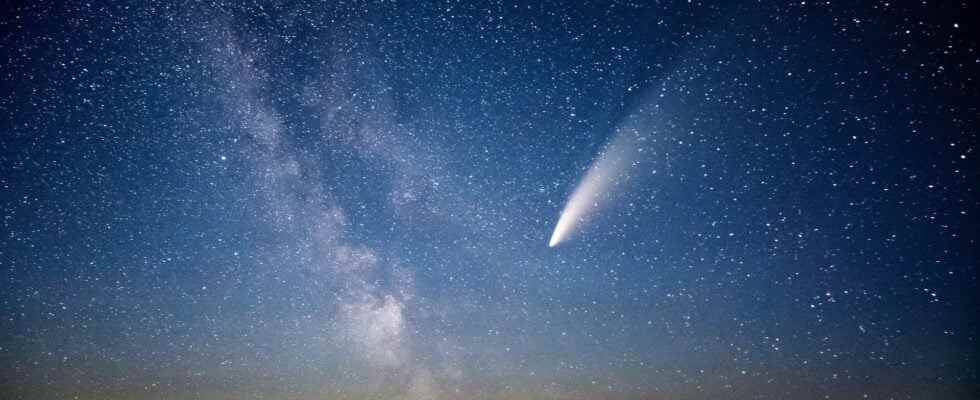Four planets are visible aligned in the evening, between the southeast and the east, during this month of December. A real feast for the eyes, especially since the brightest comet of the year is added, and the Geminids on the night of December 13th to 14th.
Discovered a year ago, comet Leonard was practically visible to theeye naked (below magnitude 6) in very good conditions, last week at the end of the night. She will arrive in the evening sky for the observers of thenorthern hemisphere, around the 14th, but initially drowned in the twilight lights. It will be better a few days later, when it displays below the sparkling Venus – a planet that it will also graze some 4 million kilometers away, on December 18 – from December 16 to 19. After this date, it will become very difficult to observe again, because it is too low on the horizon and weaker – its brightness will indeed drop as it moves away from the Earth to approach the Sun (perihelion January 3, 2022). Its smallest distance from Earth during its long journey through the Solar system was this Sunday, December 12 (35 million kilometers).
5 aligned planets, 3 of which are visible to the naked eye
The three aligned planets that can be admired at dusk are, in order from lowest to highest on the horizon: Venus, Saturn and Jupiter. The first, Hesperos, the evening Venus, is really not difficult to spot as its radiance is so vivid, and that, from sunset. Jupiter, a giant planet, but much more distant from us, does not go unnoticed either. They are the two brightest stars after the Moon. Note that the latter will be visible alongside them on December 8 and 9. On December 10 and 11, she will approach Neptune, fourth planet aligned in the evening sky. But to admire it, you need a relatively powerful instrument, because it is far too far from the Earth to be able to distinguish it as well as Saturn Where Jupiter. same for me Uranus, also aligned with the others on theecliptic (the plan oforbit planets around the Sun), but “hanging” above the east at this time, opposite to the procession of the planets mentioned.
A little less brilliant than its “elder” Jupiter, Saturn is nonetheless visible to the naked eye as well. It is of course in a bezel or a telescope that we enjoy the most of the spectacle of its rings and its moons.
Finally, we can almost add a fifth planet visible at dusk: Mercury. “Almost” because she is really “flush with the daisies »And therefore difficult to glance at and very furtive, slipping quickly under the horizon following the Sun. A month of December decidedly full of celestial beauties since the Geminidsrainshooting Stars remarkable!
HOME STRETCH ! #LeMagFutura
The countdown is on, the adventure will end very soon … You have until Friday 17/12 to pre-order your copy of Mag Futura and receive it in preview in your mailbox! We are on the starting blocks!
What is Mag Futura? A review of more than 200 pages, 4 files on Science which will mark 2022, zero fake news, just Science !
Why is it important to continue to support us until the last moment?
- To succeed in having a finalized format, up to your expectations: enriched with educational comics, incredible illustrations and ingenious tutorials (objective: 2,500 presales)
- To make Science accessible to the wider world and to ban fake news!
- To demonstrate that the press still has a bright future ahead of it (with 4000 presales: Mag Futura is coming out on newsstands and bookstores).
- To give us hope for the future and ensure the future of the Mag Futura project.
Meeting on Ulule to support the project ! More than ever, we are counting on you!
Interested in what you just read?
.
fs3
